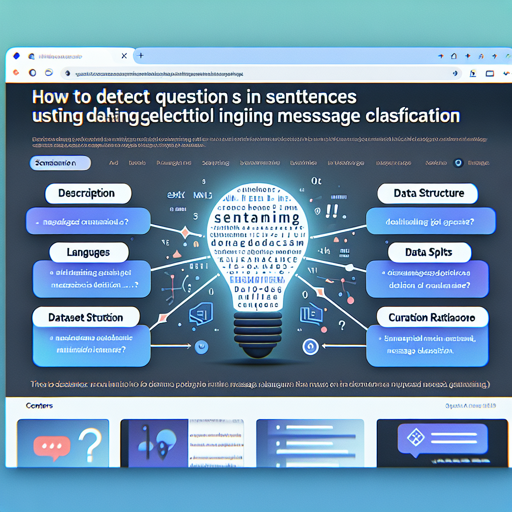In today’s blog, we will delve into an innovative approach to classify sentences, focusing specifically on identifying whether a sentence is a question. This model provides a way for bots to recognize inquiries in diverse platforms such as Slack, MS Teams, Discord, or Matrix. Let’s embark on this journey of simplifying text classification!
Table of Contents
- Description
- Summary and Intended Uses
- Languages
- Dataset Structure
- Data Fields
- Data Splits
- Dataset Creation
- Curation Rationale
- Source Data
- Annotations
- Considerations for Using the Model
- Known Limitations
Description
This model is designed to detect whether a given sentence is a question or not. The distinction lies within simple, short phrases that are commonly used in day-to-day conversations.
Summary and Intended Uses
By helping bots recognize sentences like “How are you?” or “Which ANN algorithm has Apache Lucene implemented?”, this model can enhance chatroom experiences. Examples include:
- Question: How are you?
- Question: Hello there, how are you?
- Other: Hello there, nice to meet you.
- Other: The highest mountain of Switzerland is the Dufourspitze.
- Question: Which ANN algorithm has Apache Lucene implemented?
- Other: Hi Everyone, we have a new blog post that you all might be interested in.
Languages
As of now, the model supports only the English language.
Dataset Structure
The dataset consists of simple text sentences that are either marked as a question or categorized as other types of statements.
Data Fields
- Text: Short input sentence (e.g. “Which ANN algorithm has Apache Lucene implemented?”)
- Label: Either Question or Other
Data Splits
The dataset is divided into:
- Question: 10K samples
- Other: 10K samples
- Training: 18K samples (shuffled)
- Validation: 2K samples (shuffled)
Dataset Creation
The dataset was carefully curated to include simple language examples that mimic conversation styles in chat applications.
Curation Rationale
Simple, short examples were selected as they possess similar word structures to more complex sentences, focusing mainly on conversational nuances typically found in chat formats.
Source Data
The initial data collection was sourced from GitHub where ESL language learning materials were scraped. Some samples were discarded due to quality issues, ensuring only clean data was utilized.
Annotations
The process of labeling sentences as questions or others was automated based on the context derived from conversations.
Considerations for Using the Model
While implementing, keep in mind various factors that might affect the classification accuracy.
Known Limitations
The model has some limitations, such as:
- Greeting phrases may lead to misclassification (e.g., “Hi, has anyone deployed X in Y?”).
- Sentences starting with “Wondering if…” or “I’m asking for help…” often challenge the model.
- Presence of code fragments in input sentences could skew detection.
To address issues, updates and improvements are continuously being considered to enhance performance.
Troubleshooting
If you encounter issues or inaccuracies while utilizing the model, consider the following ideas:
- Review sample sentences for clarity and context.
- Examine the dataset for any biases or imbalances.
- Ensure that the model is periodically updated to address known limitations.
For more insights, updates, or to collaborate on AI development projects, stay connected with fxis.ai.
Conclusion
At fxis.ai, we believe that such advancements are crucial for the future of AI, as they enable more comprehensive and effective solutions. Our team is continually exploring new methodologies to push the envelope in artificial intelligence, ensuring that our clients benefit from the latest technological innovations.

